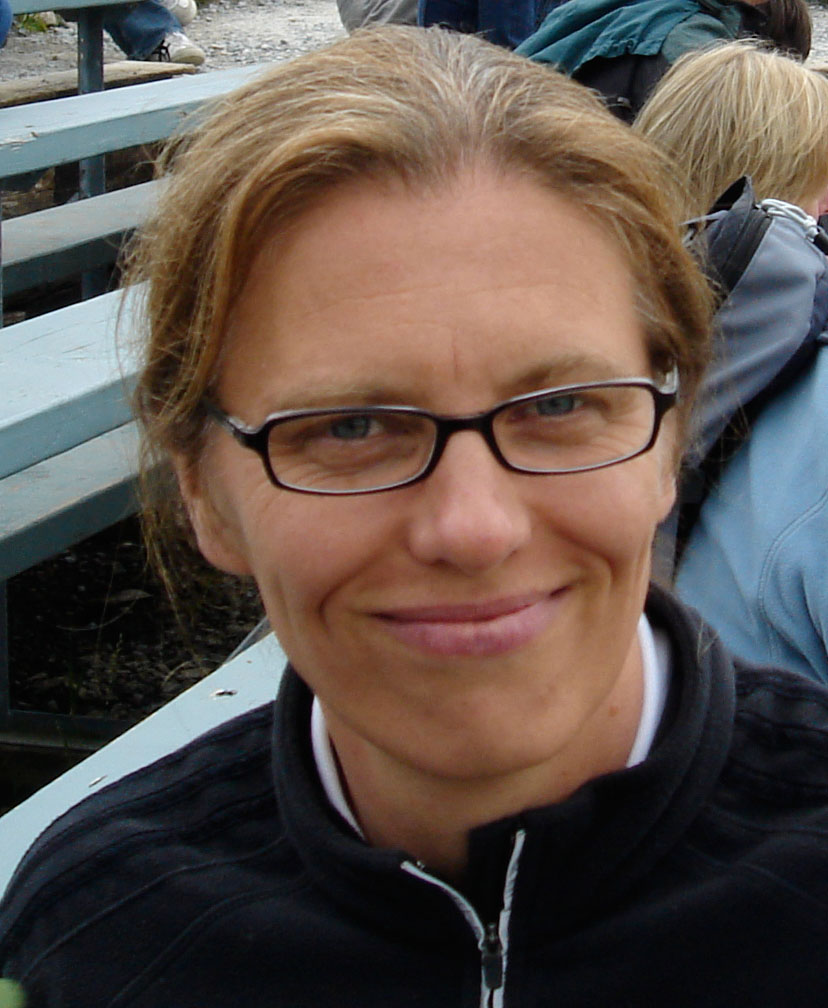Dr Lynne S. Bell
Professor
School of Criminology
Forensic Research Centre
Simon Fraser University
8888 University Drive
Burnaby, BC,
V5A 1S6
Tel: 778 782 7240
Fax: 778 782 4140
Email: lynneb@sfu.ca
www.sfu.ca/criminology
My research is concerned with the preservation of biological signatures stored within the incremental tissues of the skeleton and their forensic application to identification and the biological profile. Initially, my work focused on characterizing the microstructural arrangement of post mortem alteration (diagenesis) and establishing any taphonomic significance. Progressively, this work moved toward identifying histopathology, survival of cell structures and other biomolecules. The relationship between microstructure, isotopic signatures and mapping human movement was a logical next step. Much of my work is now focused on methodological development to extract isotopic and trace element information stored within the skeletal tissues, and to utilize these isotopic signatures to geolocate and/or track human movement.
New Book: Forensic Microscopy for Skeletal Tissues - Methods and Protocols
Deep Sea Taphonomy
An ongoing 3 year study to investigate the effects of deep ocean on decomposition. Joint project with Anderson, Bell & VENUS.
Taphonomy in motion!
Click on video to start.
| Pig submersion rig | Me puzzling over black bones |
The Living Fossil Cell
Fossilized cells in your living body!
We report here on an enigmatic and biologically mysterious event in which a single cell, the osteocyte, mineralizes in-vivo and in this process the cell’s organelles, cytoskeleton and membrane are mineralized in a dying state. This study has applied scanning and transmission electron microscopy to modern, archaeological and fossil bone and revealed that within this mineral lies an almost intact cell which is apoptotic in morphology. The mechanisms by which this cell mineralizes are so intimate chemically that remnant cell organelles, membranes, cytoskeleton and potentially mitochondrial and nucleic bodies are morphologically identifiable. We have further identified fossilized osteocytes in archaeological and fossil mammal bone up to 5 million years old. The significance of our findings demonstrates that a single cell may itself mineralize in-vivo via an unknown set of biochemical events. That such minute cell structures survive, provides evidence of a cellular event where the cell dies and in so doing, mineralizes. Importantly, the location and survival of cellular proteins, including nuclear and mitochondrial DNA in bone after death is an area of some speculation, and this unique fossil cell may provide a potential preservation locus within bone.
The Mad Trapper
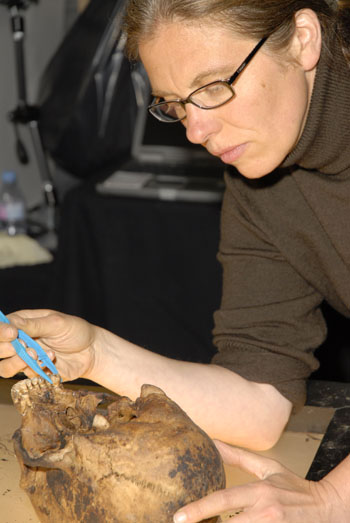 Albert Johnson arrived in Fort McPherson in July 9th 1931 and was killed on February 17th 1932 by an RCMP posse after an extended manhunt across in the Canadian high arctic. The manhunt became international news and its progress was monitored internationally via radio as far away as the UK and the US. The expression “the RCMP always get their man” comes from this chase and his final capture. His true identity has always been questioned and a forensic team was tasked to exhume and identify his body. I joined the team and undertook isotopic work using oxygen, nitrogen and carbon stable isotopes to assess his geographical origin and also his diet. My participation was funded by the CPRC and the results form part of a Discovery Channel documentary.
Albert Johnson arrived in Fort McPherson in July 9th 1931 and was killed on February 17th 1932 by an RCMP posse after an extended manhunt across in the Canadian high arctic. The manhunt became international news and its progress was monitored internationally via radio as far away as the UK and the US. The expression “the RCMP always get their man” comes from this chase and his final capture. His true identity has always been questioned and a forensic team was tasked to exhume and identify his body. I joined the team and undertook isotopic work using oxygen, nitrogen and carbon stable isotopes to assess his geographical origin and also his diet. My participation was funded by the CPRC and the results form part of a Discovery Channel documentary.
Geographical tracking in the UK
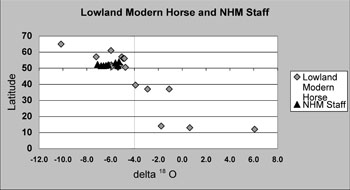
This paper gives results from a stable oxygen isotope assessment of modern human and horse enamel δ18O values recovered from tooth enamel. The human and horses were all constrained to known geographic locales for the period of tooth formation and compared to UK and global precipitation values for δ18O. It was found that human and horse values track one another and horse can be used with some confidence as a human proxy. UK values were constrained geographically and outlier values to the UK were identified between Iceland and the Sudan. For application within the realm of forensic science more research is required to understand the regionalized contribution of hydrology to a catchment and the potentially confounding contribution of mixed water sources. However, as a tool to track human movement within forensics there is clear utility. A range of values characteristic of the UK was identified and therefore anything outside of this range could be excluded from the UK.
The Mary Rose Warship
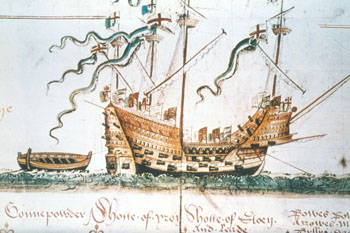 The cause of the sinking of Henry VIII's Vice Flagship, the Mary Rose, as she sailed out to meet the French fleet on 19th July AD 1545, has remained an enduring mystery; at the time, the French claimed that the ship was holed by French canon fire whilst the British maintained that she sank due to a poorly executed navigational manoeuver. On the day of the sinking there was a total crew complement of 415 men onboard. Minimum number analysis of the commingled human assemblage identified only 179, from which we sampled 18 individuals from differing decks within the ship. We measured δ13C and δ15N in bone collagen, and δ18O and δ13C in enamel apatite of these individuals in order to obtain information about their diets and origins. While the collagen δ13C and δ15N data are similar to other medieval populations, the δ18O data indicate that a significant proportion of the crew did not originate in Britain, but rather they came from warmer, more southerly, regions of Europe. These data suggest the presence of 33-60% of non-natives, possibly mercenaries, amongst the crew. Together with the contemporary remark shouted from the Mary Rose to a passing ship, that the Captain had the "type of knaves of whom he could not rule", our results lend weight to the suggestion that poor communication contributed to the disaster (see Bell et al. 2009, 2010)
The cause of the sinking of Henry VIII's Vice Flagship, the Mary Rose, as she sailed out to meet the French fleet on 19th July AD 1545, has remained an enduring mystery; at the time, the French claimed that the ship was holed by French canon fire whilst the British maintained that she sank due to a poorly executed navigational manoeuver. On the day of the sinking there was a total crew complement of 415 men onboard. Minimum number analysis of the commingled human assemblage identified only 179, from which we sampled 18 individuals from differing decks within the ship. We measured δ13C and δ15N in bone collagen, and δ18O and δ13C in enamel apatite of these individuals in order to obtain information about their diets and origins. While the collagen δ13C and δ15N data are similar to other medieval populations, the δ18O data indicate that a significant proportion of the crew did not originate in Britain, but rather they came from warmer, more southerly, regions of Europe. These data suggest the presence of 33-60% of non-natives, possibly mercenaries, amongst the crew. Together with the contemporary remark shouted from the Mary Rose to a passing ship, that the Captain had the "type of knaves of whom he could not rule", our results lend weight to the suggestion that poor communication contributed to the disaster (see Bell et al. 2009, 2010)
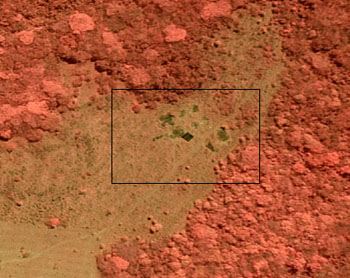 Costa Rican Mass Grave Project
Costa Rican Mass Grave Project
The Costa Rican Mass Grave Project (CRMGP) is a joint project with Dr Margaret Kalacska (McGill). Its purpose was to determine if remote sensing imagery could be used to detect mass graves utilizing flyover and satellite derived hyperspectral and multispectral imagery. A number of experimental graves were created some containing bodies and some empty. The CRMGP was initially modeled on smaller graves exhumed in Guatemala and was designed with similar conditions in mind. The technology itself may be deployed potentially around the world, but will require further experimental systems to model out differing climatic and ecological regimes. Our results to date demonstrate that it is possible to detect a grave which contains bodies to an identical feature (grave) which does not.
Other work
Diagenetic alteration to skeletal tissues is important to understand and identify to avoid contamination of biomolecular protocols and also to establish any taphonomic significance. At a microstructural level changes seen below may be ascribed certain taphonomic meaning giving information on what has happened to the body after death.
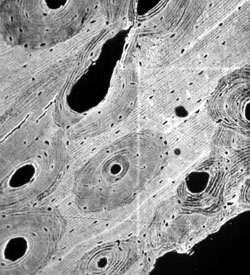
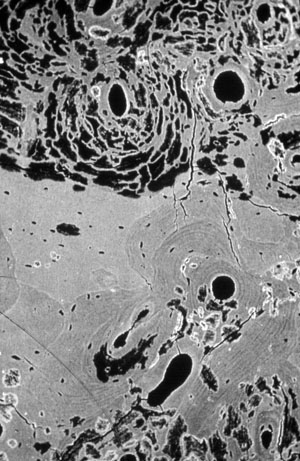
1. Normal bone 2. Bacterial remodelling
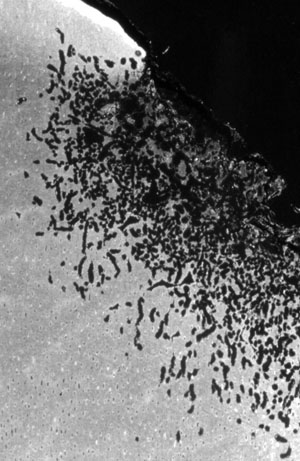
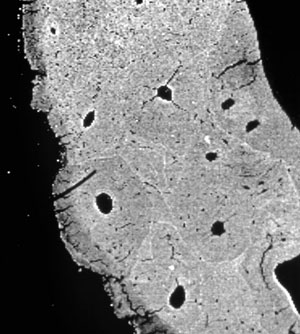
3. Marine exposure 4. Terrestrial exposure
Editor: Bell L.S. (2012) “Forensic Microscopy for Skeletal Tissues: Methods and Protocols.” MMB Series, Humana Press, Springer, New York
Bell L.S. (2012) Identifying post mortem microstructural change to skeletal and dental tissues using backscattered electron imaging. In: Editor: Bell L.S. “Forensic Microscopy for Skeletal Tissues: Methods and Protocols.” MMB Series, Humana Press, Springer, New York, 915, pp. 173-190
Wighton T., Jones C. & Bell L.S. (2012) Plastic embedding of bone for thin section and electron microscopy. In: Editor: Bell L.S. “Forensic Microscopy for Skeletal Tissues: Methods and Protocols.” MMB Series, Humana Press, Springer, New York, 915, pp. 21-36
Bell L.S. (2011) Forensic science in support of wildlife conservation efforts: morphological and chemical analysis approaches (global trends). Forensic Science Review, 23, 30-35 [PDF]
Bell L.S. Histotaphonomy (2011) In: “Bone Histology: An Anthropological Perspective” Eds. Stout S. & Crowder C. CRC Press, New York, pp. 241-251
Bell L.S., Lee-Thorp J. A. & Elkerton A. (2010) Sailing against the wind. Journal of Archaeological Science, 37, 683-686
Anderson G.S. & Bell L.S. (2010) Deep coast marine taphonomy: interim results from an ongoing investigation of decomposition in the Saanich Inlet, British Columbia. Proc. Am. Acad. Foren. Sci., 16, 381-382
Bell, L.S. & Lee-Thorp, J.A. & Elkerton A. (2009) The sinking of the Mary Rose warship: a medieval mystery solved? Journal of Archaeological Science, 36, 166-173
Kalacska M, Bell L.S., Sanchez-Azofeifa G.A. & Caelli T. (2009) The application of remote sensing for detection of mass graves: an experimental case study from Costa Rica. Journal of Forensic Science, 54, 159-166
Bell L.S., Kayser M. & Jones C. (2008) The mineralized osteocyte: a living fossil. American Journal of Physical Anthropology, 137, 449-456
*Calvo-Alvarado J.C., Kalacska M., Bell L.S. (2008) Effect of soil type on the reflectance of tropical tree and grass In: Hyperspectral Sensing of tropical and sub-tropical forests, (Eds.) Kalacska M, Sanchez-Azofeifa G.A. (Eds), CRC Press, pp. 141-159
*Bell L.S.& Elkerton A. (2008) Human remains recovered from a Sixteenth century mass fatality: unique marine taphonomy in human skeletal material from the medieval warship the Mary Rose. International Journal of Osteoarchaeology, 18, 523-535 [PDF]
Kalacska M, Bell L.S. & Theissen B. (2007) Remote detection of clandestine graves. Blue Line, 19, 2, 8-10
Hillier M & Bell L.S. (2007) Differentiating human bone from animal bone: a review of histological methods. Journal of Forensic Science, 52, 249-263
Bell L.S., Lee-Thorp J.A. & Dobney K. (2006) Mapping human movement using stable oxygen isotopic mass spectrometry: potential application to forensic science. Canadian Society of Forensic Science Journal, 39, 47-54 [PDF]
Kalacska M. & Bell L.S. (2006) Remote sensing as a tool for the detection of clandestine mass graves. Canadian Society of Forensic Science Journal, 39, 1-13
